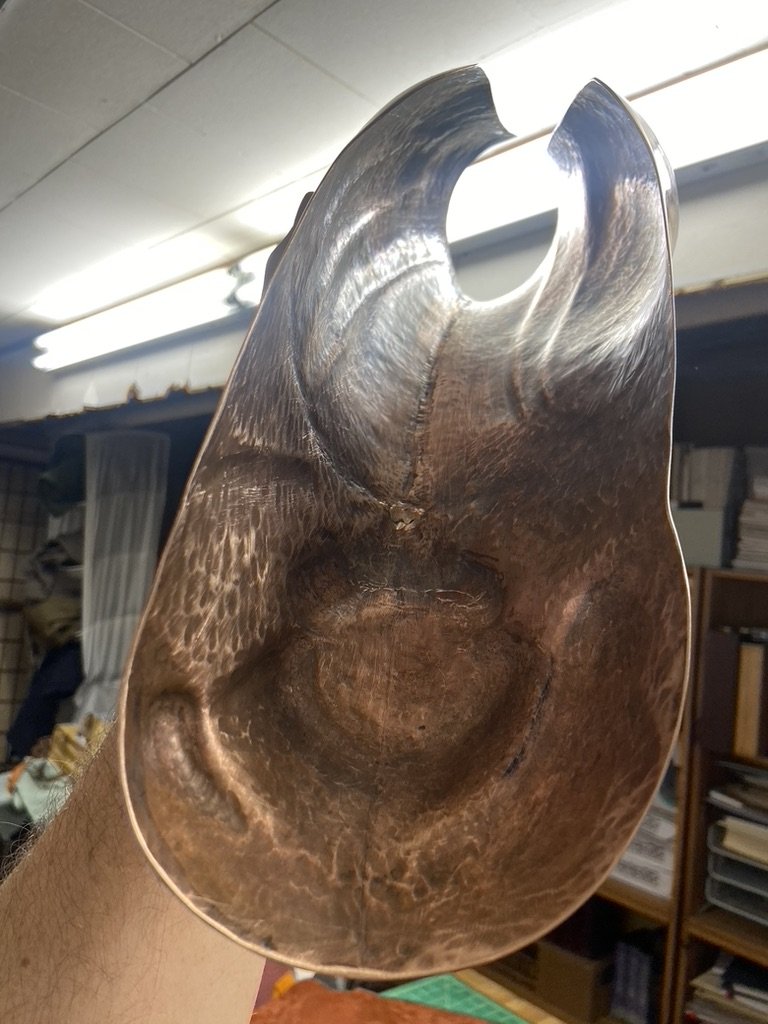Knemides (Greaves)
By Andrew Yamato
Simple in concept but complicated to make, these are usually the most expensive and least essential elements of the panoply.
Despite their elegantly simple form – single plates of bronze wrapped around the lower leg from just above the ankle to just above the knee – greaves are in many respects the most challenging part of the panoply to get right. This is precisely because of their elegantly simple form, which must closely follow the contours of the leg for a comfortable and secure fit – ideally without the benefit of straps or laces. This generally requires a pair of custom-made greaves, which can easily become the most expensive part of a panoply.
Different styles of greaves have been dated to different eras. Very approximately, bronze greaves in the early Archaic era were thicker, shorter, more ornately decorated, and more likely to have holes or rings in back for the attachment of straps or lacing. By the later Archaic era, improved metallurgy and metalworking allowed for more anatomically modeled greaves made of thinner, more flexible bronze that clipped onto the lower leg (now covering the knee as well) without the need for straps or lacing (although these were often added later to better later owners). By the 4th century BCE, the practical demands of larger, professional armies equipped by the state with relatively mass-produced armor saw straps and/or lacing on greaves again became the norm.
Our Recreation
Unless you happen to live near one of the very few armorers in the world able to make these, you’ll need to make molds of your legs. This entails first wrapping your legs in Saran Wrap, and then the careful wrapping of your legs with moistened “ScotchCast” tape, which dries hard. (Not yet having realized that ScotchCast existed, we used water-activated packing tape, which worked fine.) Once the tape is dry, but before you cut it off, you’ll want to mark any prominences you’d like your armorer to be mindful of.
Our greaves were commissioned from Adam Maziar in Poland. I wanted something as close as possible to the famous “Denda” greaves for mine: naturalistically anatomical with no ornamentation. John’s greaves feature extremely detailed gorgon repousse relief on the knees. Based upon Adam’s research, they are made from 1.2 mm B8 bronze (92% copper, 8% tin), hammered out in parts to 0.8mm. John’s greaves weigh 1063g each before lining; mine weigh 1360g each after lining. Almost certainly a bit on the heavy side, but not too far off the mark, and lighter than any other modern replicas we’ve been able to find.
Different methods and materials can be used for lining greaves. A glued-in felt lining has the benefit of being lightweight, we went with linings made in heavier, soft leather to help the greave grip the calf. Wrapped slightly around the edge of the greave, the leather creates the slight ridge around the greave’s circumference often seen in artwork, while also making the greaves more comfortable to slide on and pull off.
I suspect that even the most perfectly fitting greaves tend to slip south; they’re held on by gripping musculature that shifts with every movement, and gravity doesn’t miss a beat. Unless your greaves are cut quite high above the ankle (which is sometimes seen in art), this slippage needs to be somehow countered to keep the greaves off your instep. The simplest and easiest solution is to wear sandals with ankle straps. If you prefer to go barefoot, we see in artwork that leather cuffs could be tied around the ankles as cushioned supports.
One last note regarding greave fit: given the need for a well-fitting greave to tightly grip the calf muscles while maintaining its shape during the donning and removal process, this might be an instance where the choice of metal is more than cosmetic. (See “Bronze or Brass” below) B8 seems to have this natural springiness; brass less so.

